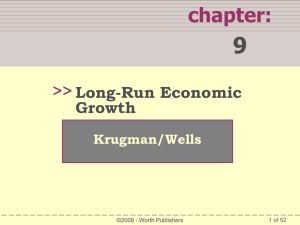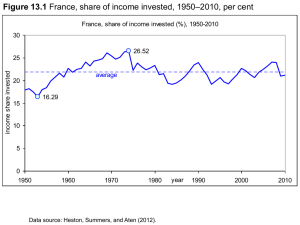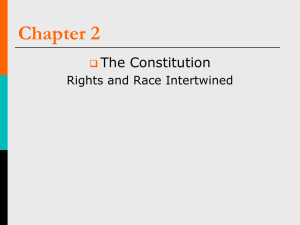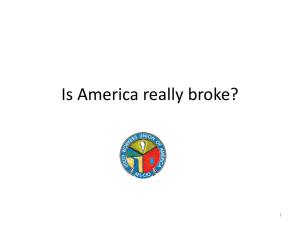The Wealth of Nations and Economic Growth
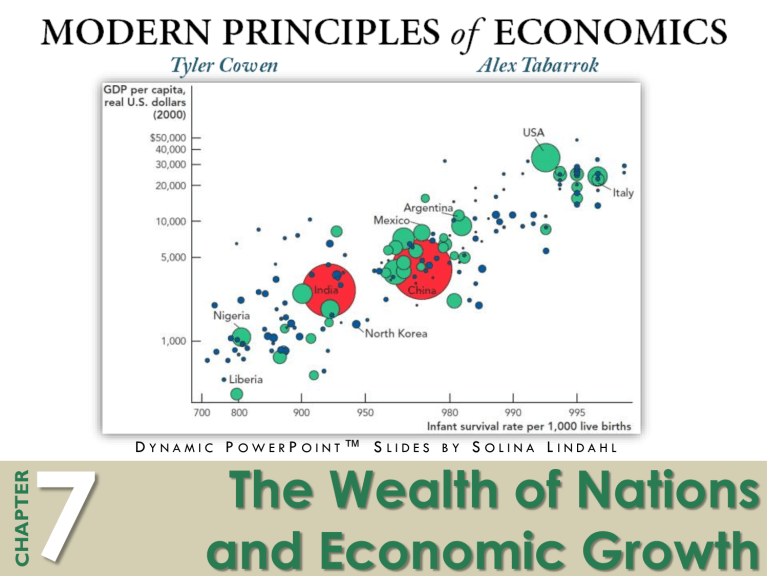
7 D Y N A M I C P O W E R P O I N T ™ S L I D E S B Y S O L I N A L I N D A H L
The Wealth of Nations and Economic Growth
CHAPTER OUTLINE
Key Facts about the Wealth of Nations and
Understanding the Wealth of Nations
For applications, click here
Food for Thought….
Some good blogs and other sites to get the juices flowing:
SEE THE
INVISIBLE
HAND
Economic growth is a matter of life and death to the 1.8 million children who die of diarrhea each year globally.
Key Facts about the Wealth of Nations and
Economic Growth
Fact One: GDP per Capita Today Varies Enormously among Nations
B A C K T O
Hans Rosling debunks myths about the so-called
"developing world” with humor, data and visual flair.
(19:53 minutes) or shorter talk here (4:48 minutes)
B A C K T O
Key Facts about the Wealth of Nations and
Economic Growth
Wealth and Health go Together.
Source: Penn World Tables and World Bank Group, World Development Indicators, 2005 B A C K T O
Key Facts about the Wealth of Nations and
Economic Growth
Fact Two: Everyone Used to be Poor
B A C K T O
Key Facts about the Wealth of Nations and
Economic Growth
A Primer on Growth Rates
How is economic growth measured?
g t
y t
y t 1 y t 1
100
Where y t is per capita real GDP in year t
Example:
Year real GDP per capita
2008
2009
$15,000
$15,500 g
2009
15 , 500 15 , 000
100
15 , 000
3 .
33 %
B A C K T O
The Rule of 70 (The Magic of Compounding)
The rule of 70:
Doubling time
70 growth rate in %
Example: If real GDP per capita is growing at an annual growth rate of 3.5%, it will double in:
70
3 .
5
20 years.
The moral? Small improvements in growth add up fast (the power of compounding).
B A C K T O
Try it!
Let's figure out how long it will take for the average
Indian to be as wealthy as the average Western
European is today. Note that all numbers are
adjusting for inflation. India's GDP per capita is
$3,000, and let's say that real output per person there grows at 5 percent per year. Using the rule of 70, how many years will it take for India to reach Italy's current level of GDP per capita, about $24,000 per year?
a) 42 years b) 14 years c) 28 years.
d) 12 years
A Little Growth Goes a Long Way
B A C K T O
Key Facts about the Wealth of Nations and
Economic Growth
Fact Three: There are Growth Miracles and Growth Disasters
B A C K T O
Try it!
Would you rather live in a country that has high taxes and a generous social safety net or a country with low taxes and little social safety?
a) High tax, generous social safety b) Low tax, low level of social safety
Understanding the Wealth of Nations
The Factors of Production are important
Physical capital: the stock of tools including machines, structures, and equipment.
Human capital: is the productive knowledge and skills that workers acquire through education, training and experience.
Technological knowledge: knowledge about how the world works that is used to produce goods and services.
B A C K T O
What Causes Economic Growth?
B A C K T O
Understanding the Wealth of Nations
Why do some nations have faster growth than others?
Besides factors of production, incentives and institutions matter.
Institutions = “rules of the game” that structure economic incentives.
Institutions of Economic Growth
1. Property rights
2. Honest government
3. Political stability
4. A dependable legal system
5. Competitive and open markets
B A C K T O
Korea’s Experiment
Before division after WWII: similar
Culture, physical capital, technology.
North Korea became a communist state with a centrally planned economy.
South Korea adopted the capitalist free market model.
B A C K T O
SEE THE
INVISIBLE
HAND
North and
South
Korea at night
Institutions
1. Property rights:
Provide incentives to work hard.
Encourage investment and innovation.
Without property rights:
Effort is divorced from payment, reducing incentives.
Free riders become a problem.
B A C K T O
Institutions
Free Rider = someone who consumes a resources without working or contributing to the resource’s upkeep.
China’s “Great Leap Forward”- which introduced farming collectives- reduced incentives. 20-40 million starved.
1978, farmers in Xiaogang met in secret to devise a plan to keep some of their produce.
(background photo)
Productivity improved so quickly the government allowed the experiment to proceed.
Food production increased 50% in 5 years 1978-1983.
B A C K T O
Institutions
• No one must “own” you for economic freedom to exist.
• Ownership is right to shape, use, and dispose.
• You wouldn’t think you really owned it if the government
• The government would be the de facto owner.
• Ownership is control, without it you don’t “own” it.
• Mongolian Yaks – were owned by the government for decades (the People’s Yaks)
• Total Yak population did not change from 1920s to 1990s
B A C K T O
Institutions – Property Rights
• After the collapse of central planning, property rights were assigned.
• The Yak population soared from 25 to 32 million in a few short years
• When it’s your yak, not “ everybody’s ” yak, you take care of the yak and make more yaks
• You “share” your Yaks with other people with mutually beneficial trades involving yak products.
• “Sharing” when done at gun point (i.e. government confiscation of property) is not the proper term to use.
B A C K T O
Institutions
2. Honest Government
Property rights are meaningless unless government guarantees property rights.
Corruption bleeds resources away from productive entrepreneurs.
Corruption takes resources away from more productive government activity.
B A C K T O
Corruption and Growth
Don’t go Together
Source: Penn World Tables and World Bank Group, World Development Indicators, 2005
B A C K T O
Corruption Who’s Who List
B A C K T O
Institutions
3. Political Stability
Changing governments without the rule of law creates uncertainty which leads to less investment in physical and human capital.
In many nations civil war, military dictatorship, and anarchy have destroyed the institutions necessary for economic growth.
Bullet casings from Liberia’s Civil War: Bad soil for anything to grow.
B A C K T O
Institutions
4. Dependable Legal System
A good legal system facilitates contracts and protects property from others (including government).
Poorly protected property rights can result from too much government or too little government.
In India, residents who purchase land have to do so more than once because of lack of proper record keeping.
B A C K T O
Institutions
4. Dependable Legal System
“Rule of Law” – crucial to economic growth
The rule of law is the general concept that government as well as the governed are subject to the law and that all are to be equally protected by the law.
Otherwise…..worst kinds of corruption
Power does not equal wisdom or good judgment
B A C K T O
Institutions
4. Dependable Legal System
• Most of human history the rules by which life was governed were usually determined by force and fraud
• He who had the power made the rules.
Absolute monarch or tyrannical despots
• “Divine right of Kings” subjects accepted their rule without question
B A C K T O
Institutions
5. Competitive and Open Markets
Encourage the efficient organization of resources.
One study found: if India used its physical and human capital as efficiently as the U.S., India would be 4x richer than it is today.
B A C K T O
Try it!
India and China come up a lot in this chapter.
What fraction of humans live in India and China together?
a) Roughly 1/2 of all humans.
b) Roughly 1/4 of all humans.
c) Roughly 1/3 of all humans.
d) Roughly 1/5 of all humans.
Institutions
Why do poor countries use their capital inefficiently?
Whether inadvertently or not, inefficient and unnecessary regulations:
Create monopolies and impede markets
Example: until recently in India, it was illegal to produce shirts using large-scale production
Economies of scale = the advantages of large-scale production that reduce average cost as quantity increases
B A C K T O
Try it!
Think-pair-share: Why do you think expensive red tape is hard to get rid of in many poor countries?
Institutions and Growth Miracles
Revisited
Why did England’s Industrial Revolution bring us:
large scale factories
mass production
the steam engine
the railroad
the beginnings of a consumer society
the first sustained rise in human living standards above subsistence?
B A C K T O
Institutions and Growth Miracles
Revisited
Property rights?
England’s geography and Navy helped protect property rights
Honest government
Growth of Parliament (and religious changes) reduced royal tyranny
Political stability
Middle class developed from growth
A dependable legal system
Less corruption as royal and Catholic power is reduced
Competitive and open markets
England opened itself more to trade
B A C K T O
Try it!
What is the difference in GDP per person between Nigeria and
Argentina?
a) The GDP per person in both countries is roughly the same.
b) Argentina's GDP per person is about $9,000 > Nigeria's c) Nigeria's GDP per person is about $9,000 > Argentina's d) None of the above
B A C K T O





